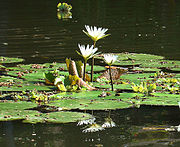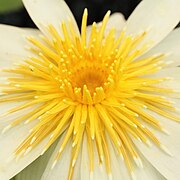| Nymphaea ampla | |
|---|---|

| |
| In bloom in Guatemala | |

| |
| Botanical illustration | |
| Scientific classification | |
| Kingdom: | Plantae |
| Clade: | Tracheophytes |
| Clade: | Angiosperms |
| Order: | Nymphaeales |
| Family: | Nymphaeaceae |
| Genus: | Nymphaea |
| Subgenus: | Nymphaea subg. Brachyceras |
| Species: | N. ampla |
| Binomial name | |
| Nymphaea ampla (Salisb.) DC. | |
| Synonyms | |
| |
Nymphaea ampla, the dotleaf waterlily, is a species of flowering plant in the family Nymphaeaceae. It is native to Texas, Florida, Mexico, Central America, the Caribbean, and northern and western South America.
Cytology
The chromosome count is n = 14. The genome size is 772.62 Mb. The chloroplast genome is 159879 bp long.
Cultural significance
Nymphaea ampla is widely represented in Mayan art, especially in its depictions with jaguars and Mayan kings. Its cultural importance can be seen in one of the Mayan names of the plant; nikte’ha’ ("vulva of the water") as it would have represented life, sexual activity, fertility, and birth. The plant causes opiate-like effects on the user and is known to have been used as a calmative and mild trance inducer.
Conservation
In Guadeloupe it has been classified as near threatened (NT) in the France red list.
Gallery
-
 In Lake Nicaragua
In Lake Nicaragua
-
 At the Bergianska trädgården
At the Bergianska trädgården
-
 Close-up of flower
Close-up of flower
References
- ^ "Nymphaea ampla (Salisb.) DC". Plants of the World Online. Royal Botanic Gardens, Kew. Retrieved 19 August 2022.
- "Nymphaea ampla". Plant Database. Lady Bird Johnson Wildflower Center. 13 July 2020. Retrieved 19 August 2022.
- Chen, F., Liu, X., Yu, C., Chen, Y., Tang, H., & Zhang, L. (2017). "Water lilies as emerging models for Darwin’s abominable mystery." Horticulture research, 4.
- Gruenstaeudl, M., Nauheimer, L., & Borsch, T. (2017). Plastid genome structure and phylogenomics of Nymphaeales: conserved gene order and new insights into relationships. Plant systematics and evolution, 303, 1251-1270.
- Emboden, W.A. (1979) "Nymphaea ampla and Other Mayan Narcotic Plants." Mexicon 1:50–52.
- Nymphaea ampla (Salisb.) DC., 1821. (n.d.). Inventaire National Du Patrimoine Naturel. Retrieved July 3, 2023, from https://inpn.mnhn.fr/espece/cd_nom/630229?lg=en
This angiosperm-related article is a stub. You can help Misplaced Pages by expanding it. |